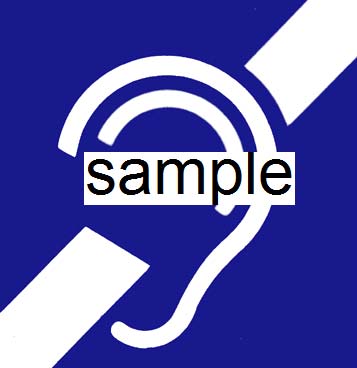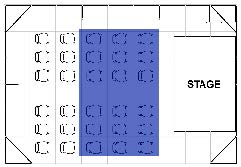Contents
- Introduction
- Relevant legislation
- Signage requirements
- International symbol for deafness
- Braille and tactile information
- Sign examples
Free licence
Deafness Forum Ltd assigns the right to another party to reproduce this Signage Guide, but retains all other rights, including a requirement that the other party attributes this work to the copyright owner. This Guide must be must be reproduced in full.
© Deafness Forum Ltd 2013-2018
Disclaimer
At the time of collation, all information contained in this guide was current. Due to ongoing improvements in access requirements, we strongly recommend that people designing buildings and ordering or installing signs consult the most up-to-date legislation, codes, standards and advisory notes.
Introduction
Hearing Augmentation is required in all places where sound amplification is provided or public announcements are made, for example: boardrooms, class/lecture rooms, rooms used for judicial purposes, assembly halls, cinemas, theatres and auditoriums.
The International Deafness Symbol is displayed to indicate the presence of a Hearing Augmentation System.
Infrared Systems
These generally require a direct unblocked line of sight to the user and require users to obtain and wear a receiver with the appropriate attachment. They can be used without hearing aids.
FM Systems
These also require users to obtain and wear a receiver.
Audio-Frequency Induction Loop Systems (Hearing Loops)
These loops are usually installed in meeting rooms or in other places where people gather. They assist people who have hearing aids fitted with a T-switch. They can even assist people without hearing aids if the user is provided with a loop receiver device.
In addition to permanently installed hearing loops, there are portable hearing loops for purchase or hire. These can be used in small spaces such as meeting rooms or motor vehicles.
This guide aims to provide information so that architects, building designers, project managers, building surveyors, venue managers and audio-visual integrators can be better informed of their communication access responsibilities and to assist them in providing and locating appropriate signage for Hearing Augmentation.
The information is correct at the time of publication however, as requirements and standards are updated, the most recent legislation, BCA and Australian Standards and advisory notes should be consulted for the most up-to-date information.
In addition to the information contained in this guide, it is recommended that:
- Adjacent to your signs, provide contact information for a person – name, location and/or SMS text – who can attend to any faults noticed by a person who requires the advertised communications access.
- Conduct regularly scheduled listening checks of any Hearing Augmentation System (Hearing Loop, FM or IR system) to ensure it is operating correctly.
Relevant legislation
The mandatory requirements for Hearing Augmentation are contained in:
- Building Code of Australia (BCA) – 2012 – Section D3.7 and non-mandatory requirements are also referenced in:
- Australian Standard 1428.5 – 2010 Section 3 and 4, Appendix A, B &C
The mandatory requirements for Signage for Hearing Augmentation are contained in:
- Building Code of Australia (BCA) – 2011 – Section D3.6 and Specification D3.6
- Australian Standards 1428.1 – 2009 Amdt 1, Clause 8.2.2 and Figure 12 and non-mandatory requirements are also referenced in:
- Australian Standard 1428.5 – 2010 Section 5
- This guide should be read in conjunction with these documents.
For public transport buildings only
The mandatory requirements for Hearing Augmentation are contained in:
- Building Code of Australia (BCA) – 2012 – Section H2.13
- Australian Standard 1428.2 – 1992 Clause 21.1
- and non-mandatory requirements are also referenced in:
- Australian Standard 1428.5 – 2010 Section 3 and 4, Appendix A, B &C
The mandatory requirements for Signage for Hearing Augmentation are contained in:
- Building Code of Australia (BCA) – 2011 – Section H2.10
- Australian Standards 1428.1 – 2001 Clause 14.3 and Figure 34
- Australian Standards 1428.2 – 1992 Clause 17.1, 17.4, Figure 30 and Table 1 and non-mandatory requirements are also referenced in:
- Australian Standard 1428.5 – 2010 Section 5
This guide should be read in conjunction with these documents.
The information contained in this guide is correct as at July 2013 however, as requirements and standards are updated, the most recent legislation, BCA and Australian Standards and advisory notes should be consulted for the most up-to-date information.
Signage requirements
To comply with the Building Codes of Australia (BCA-2011 section D3.6), two types of signage are required:
Braille Sign at the entrance
Braille and Tactile signage (as per BCA Specification D3.6) must:
- incorporate the international symbol for deafness, (as per AS 1428.1 – 2009, Figure 12)
- The colour of the symbol shall be white on a blue background. The blue shall be B21, ultramarine, of AS 2700, or similar.
- identify each space with a Hearing Augmentation System,
and located as follows:
- All Braille and tactile components of the sign must be between 1200 and 1600 mm above the floor.
- on the wall on the latch side of the door with the leading edge of the sign located between 50 mm and 300 mm from the architrave (where this is not possible, the sign may be placed on the door itself).
- Signs with single lines of characters must have the line of tactile characters not less than 1250 mm and not higher than 1350 mm above the floor.
BCA Specification D3.6 defines the Braille and Tactile specification.
Printed and Braille Sign inside the room:
Printed Signage must
- incorporate the international symbol for deafness, (as per AS 1428.1 – 2009, Figure 12)
- the colour of the symbol shall be white on a blue background. The blue shall be B21, ultramarine, of AS 2700, or similar.
- identify the area covered within the room with a Hearing Augmentation System,
- identify the type of Hearing Augmentation System (i.e. Hearing Loop System, Infrared System or FM System),
- if receivers are being used and where the receivers can be obtained.
- comply with the Braille requirements in 1.(d), (e) and (f) above.
Different requirements apply to public transport buildings.
International symbol for deafness
The International Symbol for deafness is a registered trademark in Australia, held by Deafness Forum Ltd. This provides various rights to the Deafness Forum including the right to license or sell the symbol for use within Australia for the goods and services for which it is registered.
Signs are required to incorporate the international symbol of deafness in accordance with AS 1428.1
2009 Clause 8.2.2. This symbol consists of two elements – a stylised ear and a diagonal slash on a plain square background, exactly as shown in Figure 12 of the above standard. The colour of the symbol is white on a blue background (B21, Ultramarine of AS 2700 or similar).

No variation to the symbol (or colour) is permitted.
The Symbol may not be used in an advertising context or in any way to promote or identify commercially available goods or services.
Organisations may apply for a copy of the Symbol to use in accordance with the guidelines by contacting Deafness Forum at info@deafnessforum.org.au
Lettering
Helvetica Medium or Arial typeface is preferred. Signs are easier to read in sentence case, i.e. a combination of upper and lower-case lettering, rather than lettering in all upper case or all lower case.
Sign surface
Use surface finishes that reduce glare and reflection, such as matt or non-reflective finishes which are generally more suitable. Signs should be covered by good, even light.
Braille and tactile information
Clear and legible Braille and tactile signage complying with BCA Specification D3.6 clauses 3 and 6 is required, which includes these key points:
- tactile characters must be raised by 1mm – 1.5mm above the sign surface;
- upper case tactile characters must have a height of not less than 15mm and not more than 55mm;
- lower case tactile characters must have a height of 50 per cent of the related upper-case characters;
- Grade 1 Braille must be used; and
- Braille must be left-justified and located 8mm below the bottom line of text
- on signs with multiple lines of text and characters, a semicircular braille locator at the left margin must be horizontally aligned with the first line of braille text.
- Braille must be located 8 mm below the bottom line of text (not including descenders).
Luminance contrast, lighting and colour considerations
Colour considerations are important and luminance contrast complying with BCA Specification D3.6 clauses 4 and 5 is required, which includes these key points:
- colour blindness affects an individual’s ability to distinguish between red and green and the shades in between. Avoid using colour combinations of a ripening tomato, that is green, olive green, yellow, pink and red;
- use strong contrasting colours, use dark colours against light colours or vice-versa;
- luminance contrast is the difference in the amount of light reflected from the sign compared with the light reflected from the background or surrounding surface; and
- there must be a luminance contrast of not less than 30 per cent between the raised tactile components of the sign and the surface of the sign, and the surface of the sign and the background it is mounted on.
Ordering your sign
When ordering your sign, please ensure you have stipulated that the completed sign must comply with all requirements of the BCA specification D3.6.
Sign examples
Hearing Loop System – Full Coverage

A Hearing Loop System is installed covering the
… (name of area) …
Switch your hearing aid or cochlear implant processor to T Switch, or Telecoil position.
(Braille Text Here)
Hearing Loop System – Part Coverage

A Hearing Loop System is installed covering
… (area covered) … in the
… (name of area) …
This is shown below as shaded.

Switch your hearing aid or cochlear implant processor to T Switch, or Telecoil position.
(Braille Text Here)
FM System – Full Coverage

An FM Hearing Augmentation System is installed covering the
…(name of area)…
FM Receivers are available from the
… (location of receivers) …
(Braille Text Here)
Infrared System – Full Coverage

An Infrared Hearing Augmentation System is installed covering the
… (name of area) …
Infrared Receivers are available from the
… (location of receivers) …
(Braille Text Here)
